Abbotsford | Clearbrook | Chilliwack | Yarrow | Sardis | Ryder Lake | Harrison Lake | Hope | Ladner | Langley | Fort Langley | Aldergrove | Cloverdale | Maple Ridge | Albion | Whonnock | Ruskin | Pitt Meadows | Mission | Deroche | Dewdney | Surrey | Squamish | Whistler | Pemberton
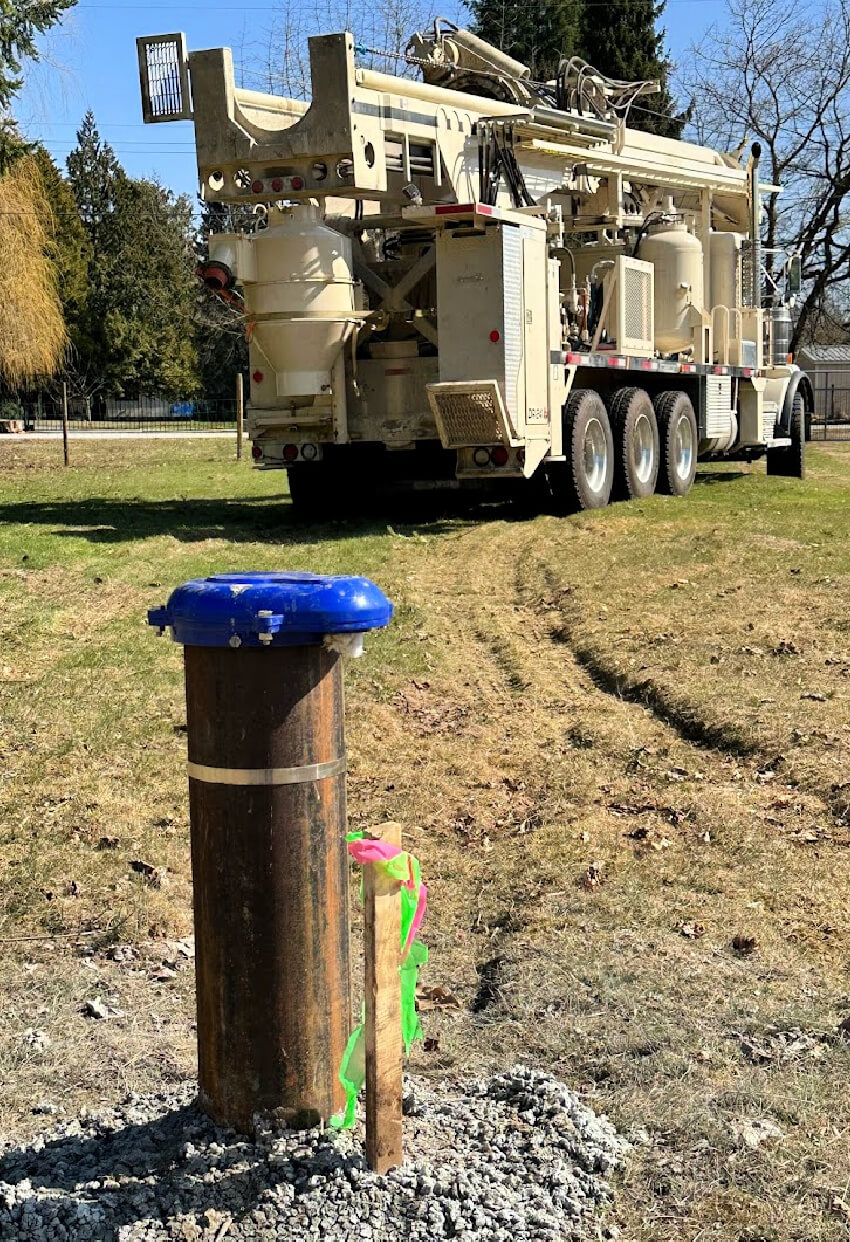
Welcome to Fraser Valley Well Drilling, your reliable guide to water well drilling in the beautiful Fraser Valley. We understand that drilling for water or considering a property without an existing water source in British Columbia can be a big decision.
That’s why we’re here: to offer transparent advice and detailed information about the costs and processes involved.
Our goal is to help you make informed decisions, whether you’re new to rural living or simply exploring your options. Let’s embark on this journey together, ensuring you have all the knowledge you need for a successful water well project.
Water wells are fundamental for life and prosperity, especially in rural areas of the Fraser Valley. The growing demand for reliable and sustainable water sources throughout British Columbia has made water well drilling an increasingly important service for thousands of rural property owners.
Fraser Valley Well Drilling sheds light on the nuances of water well drilling on the Lower Mainland, emphasizing its importance, sustainability, and the legal and environmental considerations involved
The Fraser Valley, with its diverse geography and growing agricultural and residential developments, presents unique challenges and opportunities in water well drilling. To access groundwater, a borehole is drilled hundreds of feet into the ground, lined with steel casing or well liners, and equipped with stainless steel screens to prevent sediment from entering the completed water well.
Utilizing modern water well drilling methods in the Fraser Valley reliably and effectively extracts clean water, providing a constructive approach to obtaining safe drinking water and protecting rural area property values.
The Fraser Valley’s geology significantly influences the drilling process. The region, known for its sedimentary layers deposited by the Fraser River, offers varied aquifer characteristics.
Aquifers consist of underground strata of permeable rock or materials that allow for the pumping and extraction of water. These layers serve as natural reservoirs, facilitating water accessibility from beneath the earth’s surface.
Fraser Valley Well Drilling’s experienced well drillers are licensed and skilled in navigating local drilling conditions. We prioritize identifying optimal drilling sites for water yield and quality before accessing any property.
Abbotsford, Clearbrook, Chilliwack, Yarrow, Sardis, Ryder Lake, Harrison Lake, Hope, Ladner, Langley, Fort Langley, Aldergrove, Cloverdale, Maple Ridge, Albion, Whonnock, Ruskin, Pitt Meadows, Mission, Deroche, Dewdney, Surrey, Squamish Whistler, and Pemberton region.
Request a FREE online estimate for Domestic Water Well Drilling, Commercial Well Drilling, Agricultural Well Drilling, Municipal Well Drilling, Drilling Site Selection, Water Well Repair Services, Subdivision Consulting, Water Supply Services, Hydrogeological Investigation, Well Decommissioning, Drilling Site Excavation and Site Preparation, and Water Well Inspections. Water Well Rehabilitation and Cable Tool Services
Call Us: 604-409-4931
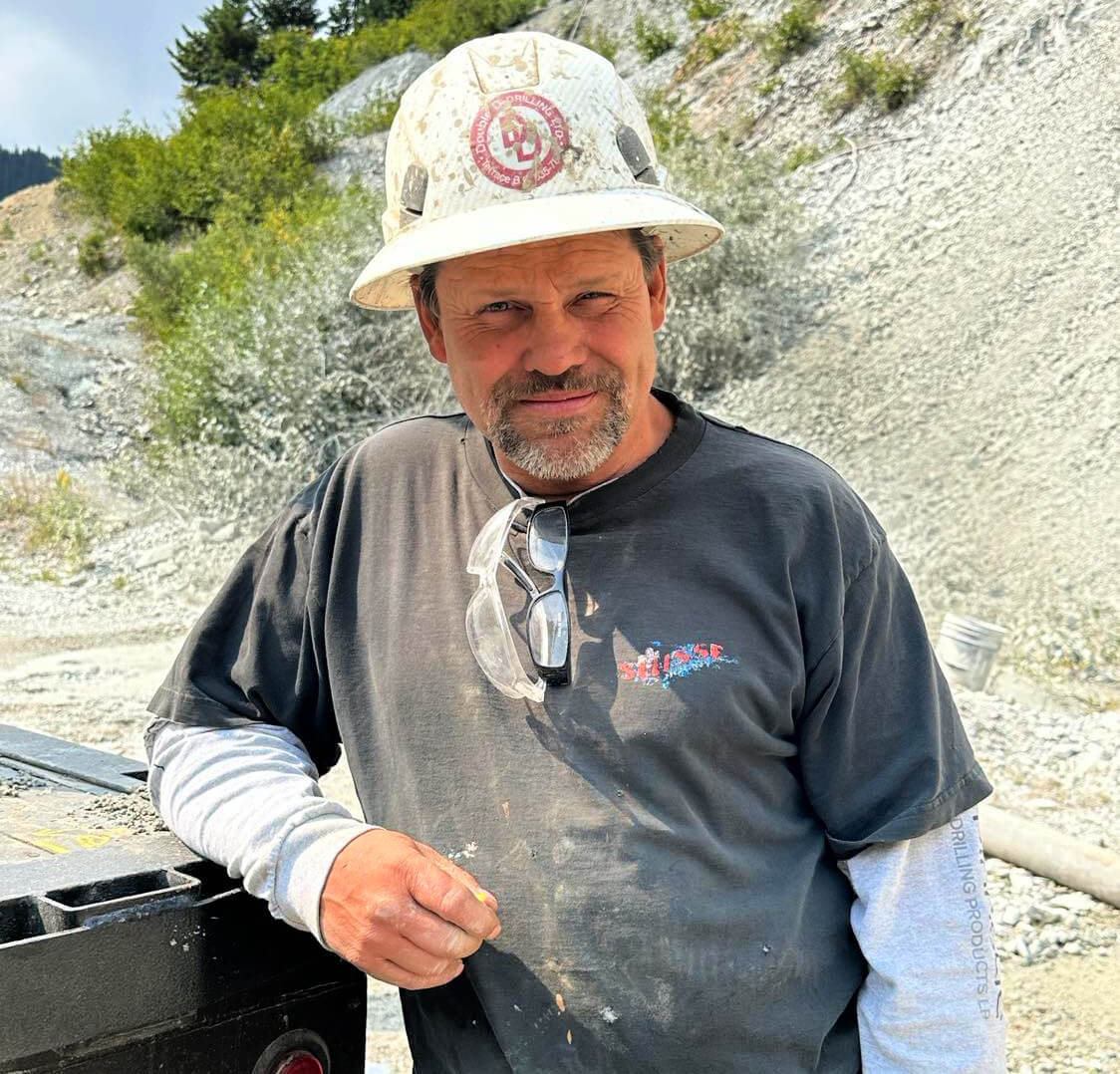
The cost of drilling for water in the Fraser Valley has significantly increased recently. As of 2023, the cost to drill a water well on the Lower Mainland is at an all-time high for domestic water wells.
Drilling a new well in the Fraser Valley will cost in the range of $13,000 on the low end to $30,000 or on some properties, even more.
When receiving a water well cost estimate, it assumes a successful drilling location on the first drilling attempt. Most people do not realize that this is not always the case; it’s not uncommon to end up with a “dry hole”, and it can happen more than once.
By far the most dreaded word in the water well industry is “dry hole.”
The risk of drilling a dry hole, which can happen anywhere in the Fraser Valley, will quickly escalate the cost of finding water on a property. Avoiding the expense of drilling a non-producing well is crucial; dry-hole drilling becomes extremely costly for property owners, and every effort needs to be made to avoid it.
The final cost of drilling a water well depends on various factors, including the local geological materials, the depth of the drilled borehole, the construction of the well, the amount of steel casing needed and its diameter, the number and type of stainless steel well screens installed, and other components that influence the drilling costs.
Before purchasing rural land for sale in the Fraser Valley or starting construction, assessing the property’s water availability is important to understand the cost of installing a new water well.
It’s wise to obtain a detailed online estimate for drilling a well in your area of the Fraser Valley, including the cost of a suitable submersible well pump package. Request your estimate online.
Our detailed water well drilling estimates are customized specifically to your property, considering the varying costs for drilling and completing new water sources in the Fraser Valley and among neighbouring properties.
Water quality should not be assumed or compared to neighbouring wells, as it can vary greatly, even between nearby wells. Prospective well owners should conduct thorough research and obtain a complete estimate for well drilling and installation of the water well pump systems.
Typically, drilling a new well is the most expensive part of the entire water well installation process. Once Fraser Valley Well Drilling completes a well, the next step is to install the well pump, usually comprising a submersible well pump, most commonly a constant pressure system.
When inquiring about the cost to drill a well in the Fraser Valley, requesting an estimate for a complete well pump package is also advisable. With a detailed well drilling estimate, we can closely calculate the cost of the water pumping system.
Consulting with an experienced well pump expert before drilling can provide valuable insights and save costs through proper planning!
Installing a new water system involves several steps; drilling the water well is often the most expensive part of the project.
Water well pump systems are crucial and should be factored into cost considerations.
Additional water well installation costs may include land excavation, surveys, pumping tests, engineering, and a water treatment system.
Request an online drilling estimate or contact Fraser Valley Well Drilling if you plan to drill a well. We have an extensive team of experienced water well experts specializing in the Lower Mainland of British Columbia, and we can assist you with any questions.
When estimating the well drilling cost budget, it’s crucial to account for the initial drilling costs and the installation of the water pump, testing, and any water treatment systems that might be necessary.
Effective budget planning for the cost of drilling a well in the Fraser Valley involves preparing for both upfront and incidental expenses. Property owners should consider setting aside a contingency fund, typically 15-25% of the estimated cost, to cover unforeseen expenses.
Water well drilling companies cannot guarantee the price, completed depth, or water quality.
Additionally, working with a reputable well drilling contractor can provide value through accurate cost estimations and potential financing plans, making drilling for water more accessible for property owners.
Investing in a water well in the Fraser Valley brings significant long-term cost benefits, especially for rural properties. The most apparent advantage is access to a reliable and independent water source. Over time, the benefits offset the initial investment in well drilling.
Furthermore, a good private water source enhances property value, making it a financially sound investment. A reliable water well for agricultural properties can increase productivity and efficiency, directly impacting revenue.
Environmental benefits also translate into cost savings. Sustainable water well practices in the Fraser Valley reduce the dependency on public water systems and the need for extensive water transportation, lowering environmental impact and associated costs.
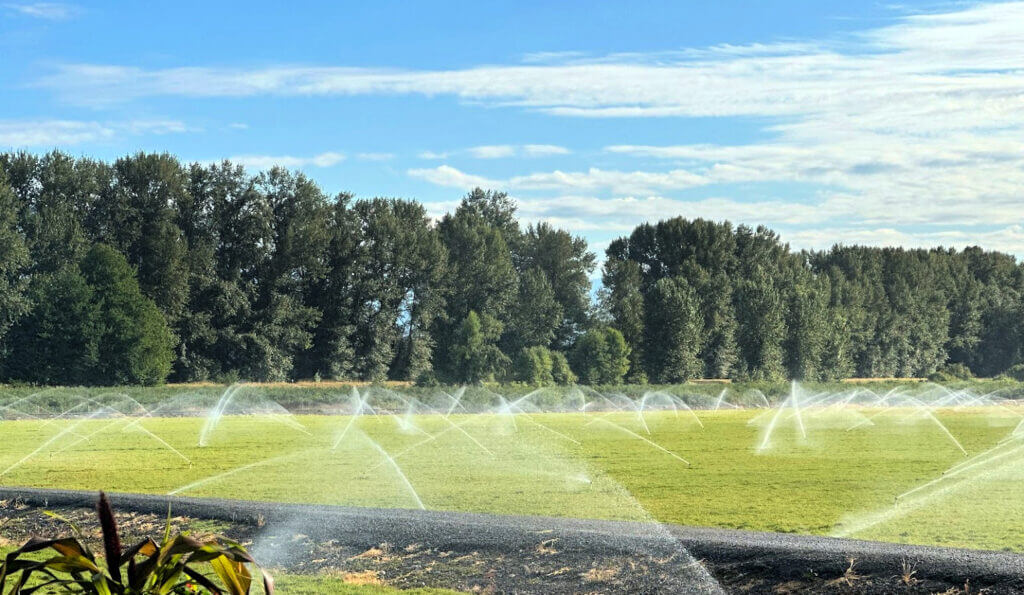
It’s important to emphasize the importance of sustainable water practices in the Fraser Valley. It’s crucial to balance the economic benefits we gain from agriculture with the need to keep our natural water sources safe and plentiful for current needs and future generations.
Think of it this way: we need to use our water wisely, ensuring our farms thrive without draining the water resources everyone in our community relies on. This approach helps us maintain a healthy balance between our livelihoods and the natural environment.
Responsible water well drilling in the Fraser Valley helps maintain the aquifers’ balance, preventing over-extraction, which can lead to decreased water quality, reduced water levels, and negative impacts on local ecosystems.
Sustainable practices also contribute to water conservation, an increasingly critical issue in the face of climate change.
Drilling a water well in the Fraser Valley involves navigating various legal and provincial environmental regulations. In British Columbia, water well drilling requires adherence to the Water Sustainability Act, which mandates licensing, reporting, and environmental assessment processes.
Compliance ensures that water extraction does not adversely affect the aquifers and surrounding environment. Additionally, property owners must consider the impact on local wildlife and plant life, adhering to environmental protection guidelines.
Navigating these legal and environmental considerations is essential for responsible water well development and sustaining the Fraser Valley’s natural resources.
Drilling water wells in the Fraser Valley is crucial for accessing underground water resources, especially in rural areas with limited surface water sources.
Understanding the basics of well drilling, the different types of water wells in the Fraser Valley, and the newest technologies is crucial for owners of rural properties, agricultural professionals, and communities in the area.
Drilling for water with Fraser Valley Well Drilling starts with an informative site visit to pinpoint the most promising site to drill a well on a property.
Remember, you are not just looking for the most suitable location to park a rig; you are looking for water!
Following the site selection for the well, preparation for drilling can begin. Drilling methods used in the Fraser Valley, such as rotary drilling or cable tool drilling, vary based on the area’s geological conditions.
Rotary drilling, the most common method, employs a rotating drill bit. In contrast, cable tool drilling (an old and slow drilling method) uses a hammering action.
In the Fraser Valley, a water well’s depth hinges on the water table’s location and the aquifer’s specific characteristics.
After reaching the required depth, the well is reinforced with casing to prevent collapse and isolate the water-bearing layers. When constructing a water well in the overburden, a well screen is installed at the base of the well to filter out sediment, ensuring clear water.
Fraser Valley Well Drilling constructs many bedrock wells; a rock hole is completed in rock and will not require a well screen. We protect all bedrock wells with a heavy-walled PVC liner to prevent bridging or collapse.
The final step involves installing a water well pumping system to draw the water to the surface.
There are mostly two types of water wells in the Fraser Valley: dug and drilled, with a few sandpoint wells around certain areas, such as Hatzic Prarie east of Mission, where the water table is not very deep. Dug wells, the more traditional form, are hand-dug and lined for stability. They suit shallow water tables but have a much higher contamination risk and other water quality issues.
Shallow wells also have a much higher risk of running dry every year as the weather heats up, leaving many Fraser Valley property owners with little choice but to either drill a new well or pay to haul bulk water from late spring until fall.
Trucking water in for months can be a miserable way to manage your private water demand. Regarding real estate deals, we see considerable non-disclosure with shallow wells. They are a buyer-beware situation; you must be careful as a purchaser.
If you have any questions regarding real estate and water wells in the Fraser Valley, don’t hesitate to give the office a call. We take the time to answer questions and make recommendations to help get you pointed in the right direction.
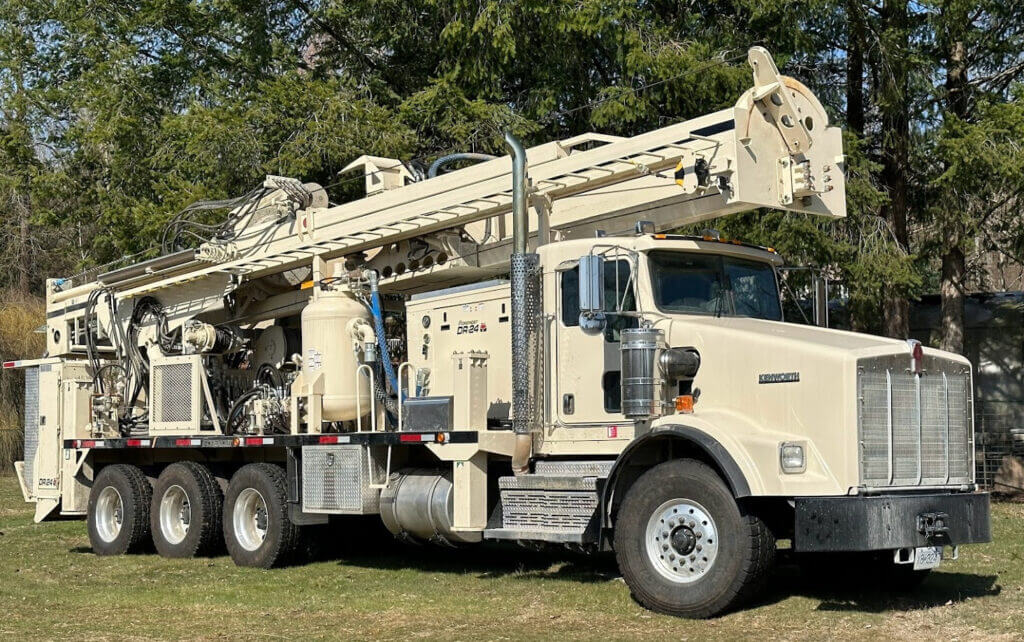
At Fraser Valley Well Drilling, we consider the dual rotary water well drilling rigs highly efficient for drilling water wells in the Fraser Valley due to several key advantages:
Versatility in Various Ground Conditions: DR rigs are effective in various geological conditions common to the Mainland of BC, from soft soil to hard rock. The dual rotary system allows for more precise control over the drilling process, making navigating challenging subsurface conditions easier.
Greater Depth and Diameter Capability: Dual rotary rigs can drill deeper and create larger-diameter wells compared to other drilling equipment types. This makes them suitable for both shallow and deep water wells, as well as for large-scale water supply projects.
Reduced Risk of Collapse in Unconsolidated Formations: The dual rotary drilling method is particularly beneficial in unconsolidated formations (like gravel or sand) with a higher risk of borehole collapse. The casing supports the borehole walls and is installed simultaneously with the drilling, providing immediate stabilization.
Efficient Drilling Speed: These rigs can achieve faster drilling speeds, especially in challenging Fraser Valley geological formations. The dual rotary action enables continuous drilling and casing, streamlining the process and reducing the time required to complete a well.
Lower Contamination Risk: Casing the well simultaneously with drilling reduces the risk of contaminating the aquifer, a significant concern in water well drilling. This simultaneous action prevents loose materials from entering the aquifer during drilling.
Reduced Water Requirement: Unlike traditional water well drilling methods that require large amounts of water, dual rotary rigs can operate with less water, which is advantageous in areas where water availability is limited while drilling.
Adaptability to Various Casing Materials: These rigs can work with a variety of casing materials, including PVC, steel, and others, offering flexibility based on the specific requirements of the well.
Enhanced Safety and Lower Environmental Impact: The drilling process is generally safer and has a lower environmental impact, as there is less generation of drill cuttings and a reduced risk of ground contamination.
In summary, the dual rotary water well drilling rigs offer a combination of efficiency, versatility, and environmental safety, making them Fraser Valley Well Drilling’s choice for many water well drilling projects. However, it’s important to note that any drilling method’s suitability in the Fraser Valley depends on each project’s specific requirements and conditions.
Our Service Area Includes Abbotsford, Clearbrook, Chilliwack, Yarrow, Sardis, Ryder Lake, Harrison Lake, Hope, Ladner, Langley, Fort Langley, Aldergrove, Cloverdale, Maple Ridge, Albion, Whonnock, Ruskin, Pitt Meadows, Mission, Deroche, Dewdney, Surrey, Squamish Whistler, and the Pemberton region.
Local Water Well Services Include Domestic Water Well Drilling, Commercial Well Drilling, Agricultural Well Drilling, Municipal Well Drilling, Drilling Site Selection, Water Well Repair Services, Subdivision Consulting, Water Supply Services, Hydrogeological Investigation, Well Decommissioning, Drilling Site Excavation and Site Preparation, and Water Well Inspections. Water Well Rehabilitation and Cable Tool Services
Call Fraser Valley Well Drilling: 604-409-4931
Well drilling in the Fraser Valley has benefited from significant technological advancements, improving efficiency, precision, and environmental safety.
Modern drilling equipment in the Fraser Valley is mostly hydraulic rotary drilling rigs that offer enhanced speed and depth capabilities, improved and safer water well construction processes, and environmentally friendly drilling fluids.
As technology has improved, so has water well maintenance and monitoring. For example, automated systems now keep track of water levels, quality, and well pump performance, making it easier to address problems immediately.
These advancements refine the water well drilling process in the Fraser Valley and support sustainable water management, ensuring the long-term reliability of water wells throughout British Columbia.
Water well drilling in the Fraser Valley is a detailed and intricate process requiring careful planning, execution, and adherence to regulations and all safety protocols.
Water well drilling in the Fraser Valley requires a specialized approach due to its unique geography; when drilling for water in the lower mainland, there are many variables to consider.
Understanding the complete process, from pre-drilling assessments to implementing safety measures, is crucial for anyone considering a water well.
A thorough pre-drilling assessment is crucial before drilling a water well. A drilling assessment begins with a comprehensive site visit to identify the best location on the property to prepare for drilling, a discussion of site access, and requirements to mobilize the drilling rig onsite.
During the initial site visit, we will also consider tree removal, regulated setbacks, and other necessities as required. Locating water is our primary focus.
The planning phase also includes selecting the appropriate well drilling method. Factors such as the expected completed depth and diameter of the well, the type of ground, and the intended use of the well (e.g., residential, agricultural, or commercial) may help guide this decision.
Our team of experienced water well experts has extensive knowledge of drilling conditions in the Fraser Valley, making informed decisions for efficient and sustainable water well development.
Fraser Valley Well Drilling follows a systematic approach:
Site Preparation: Site preparation is necessary before setting up the drill rig.
Drilling Rig Mobilized: The drilling equipment has been set up on the site and is ready to be used for drilling the well.
Installation of Steel Casing or Well Liner: After drilling to the desired depth, the well is either fully cased with steel or lined with PVC, depending on its construction.
Fraser Valley Well Drilling constructs all water wells with heavy-duty PVC liners to protect the bedrock portion of the well. We include a water well liner when estimating the cost of drilling a well on your rural Fraser Valley property.
Quality water well construction should not be optional or upsold once a rig is on a property. The well liner is a crucial component that protects your water source in the long term.
Many well drilling companies do not include liners in the initial cost to drill but will later upsell the property owner after they have completed the drilling of the well; this tactic can greatly increase the original estimated cost.
We include liners in the cost to estimate drilling expenses in Fraser Valley accurately. Water well drilling is costly enough, and a drilling company needs to be upfront and transparent about the true cost of a water well.
Well Screens: Typically, a well will have one or more 4-foot sections of stainless steel screen installed at the bottom of a drilled overburden well. Well screens are installed for several important reasons, primarily related to optimizing the performance and longevity of the water well. Here are the key purposes of screens in water wells.
Filtering Out Sediments and Particles: The primary function of a well screen is to prevent sand, gravel, and other sediments from entering the well. These particles can cause damage to pumps and other equipment, reduce the well’s efficiency, and contaminate the water supply.
Maintaining Open Access to Groundwater: Well screens have slots or openings designed to allow water to enter the well freely while keeping out larger particulate matter. This design ensures a consistent flow of water into the well.
Preventing Well Collapse: In some types of soil or geological conditions, the sides of the well can be prone to collapse. A well screen helps to support the well structure, keeping it open and functional.
Reducing Biological Growth and Chemical Precipitation: Screens can help reduce the growth of bacteria and the precipitation of minerals within the well. Both of these can clog the well and reduce its efficiency over time.
Optimizing Water Quality: By filtering out sediments and particulates, well screens play a crucial role in maintaining the overall quality of the water drawn from the well.
Prolonging Well Life: By preventing sediment ingress and supporting the well structure, screens extend the operational life of the well, reducing the need for maintenance and repairs.
Enhancing Pump Efficiency: By preventing the entry of sand and other particles, well screens help maintain the efficiency and lifespan of pumps that extract water from the well. The presence of sand or other abrasive particles in pumped water is the most damaging factor for a water well pump. These particles can cause significant wear and tear on the pump’s components, leading to pump problems.
Summary: Well screens ensure a water well’s efficient and sustainable operation. Proper screen selection is crucial for maintaining water quality, protecting well components, and extending the lifespan of a well. They help maintain water quality, protect well components, and prolong the well’s lifespan.
Water Well Development: is a critical step in the construction of a drilled water well, and it serves several important purposes:
Water Testing: The final step in ensuring safe water consumption from newly drilled wells is to test the water quality. Contaminants like bacteria, nitrates, heavy metals, and chemicals in water can pose health risks.
Testing assesses pH, hardness, mineral content, and suitability for drinking, irrigation, or industrial purposes. Timely detection and remediation of issues prevent long-term damage. Regular testing ensures safety, health compliance, well integrity, and reliable water supply.
A submersible well pump installation will be required for most newly drilled water wells in the Fraser Valley to extract water from the well. Request a well pump cost estimate online.
Consistent water pressure throughout the system is needed to operate household fixtures efficiently. The depth of the water table also influences this need, as deeper drilled wells require a well pump, such as a submersible pump, to bring water to the surface.
Fraser Valley Well Pump offers a broad selection of water well pumps, whether a submersible pump, jet pump, or another type, depending on various factors like the well’s depth, the level of the water table, and the desired water flow rate.
A well pump not only facilitates the volume and rate of water delivery suitable for the many different needs in the Fraser Valley, ranging from household to agricultural or industrial uses.
Modern well pumps are typically constant-pressure systems with automatic operation systems that increase energy efficiency and reduce wear by activating only when necessary.
When planning to drill a well in the Fraser Valley, it’s important to consider the cost of installing the water pumping system. Although drilling a well is typically more costly than the pumping system, you should not overlook the cost of installing the well pump and water system, which can also be significant.
Safety is paramount at Fraser Valley Well Drilling, where geological conditions vary.
Safety Protocols Include:
Rig Safety: Inspect and maintain drilling equipment to prevent malfunctions or accidents.
Personal Protective Equipment (PPE): Crew members are fully equipped with necessary PPE, such as helmets, gloves, and safety glasses.
Chemical Safety: When handling and disposing of drilling fluids and other chemicals, it’s important to ensure chemical safety to prevent contamination and ecological harm.
Emergency Preparedness: It is important to have a well-defined emergency response plan that includes first aid and quick access to medical services.
Training: It is crucial to provide safety training to the drilling crew to make them aware of the safety procedures and strategies to minimize risks.
Environmental: Implementing measures to protect the local ecosystem, such as containment systems to prevent spills and runoff. Ensuring responsible water well drilling practices in the Fraser Valley is crucial, as it not only safeguards the environment but also protects the workers involved.
Assign Gallons Per Minute (GPM) to Each Fixture:
Faucet: 1–2.5 GPM
Toilet: 3–5 GPM for short flush durations
Shower: 2–5 GPM (depending on the type of showerhead)
Washing Machine: 3–5 GPM
Dishwasher: 2–4 GPM
Hose Bib: (outdoor faucet): 3–10 GPM (depending on hose diameter and length)
Remember, these are just average values. It’s always better to check the manufacturer’s specifications for precise GPM ratings.
Determine simultaneous water demand:
Estimate the highest possible simultaneous water usage, such as during peak times when multiple people use water. For example, multiple showers and washing machines may be in use.
Calculate Total Peak Demand:
Multiply the GPM of each fixture by the number that you believe will be used simultaneously.
Add up the numbers.
For example, if you have:
Two showers at 5 GPM each = 10 GPM
One washing machine at 4 GPM = 4 GPM
Your total peak demand would be 14 GPM.
Add a Safety Factor:
Adding a safety factor (10–25%) to your estimated peak demand can account for any inaccuracies or unexpected future water requirement increases.
Consider Static and Dynamic Pressure:
While this is a quick guide to sizing based on demand, it’s also essential to consider the well’s depth, elevation changes, and other factors that affect pump sizing. The static (resting water) and dynamic (water level when the pump works) can influence the pump’s power needs.
Select a Well Pump:
Determining the peak water demand is crucial before selecting a pump. Choosing a pump that can meet or exceed this demand is advisable. It’s always better to have a pump that can provide more than the exact peak demand rather than one that might fall short.
Regularly Review and Adjust:
As families grow, homes get expanded, or fixtures get added/changed, the water demand can increase. Reviewing and adjusting your pump size or settings every few years or after significant changes to your home is a good idea.
Lastly, consult with Whonnock Well Pump & Repair, especially when dealing with specifics related to available water supply, well depths, geology, and pump technology. Ensuring the right pump size and type for your situation is very important.
We provide online estimates for a well pump cost in Whonnock, including installations, well pump repairs, and replacement.
Water quality is a top priority in Whonnock, especially for rural property owners sourcing water from private wells. Unlike municipal water systems, which are regularly monitored and treated to meet strict safety standards, private wells are the property owner’s responsibility.
Regular well water quality testing is essential for safeguarding
Contact Us to obtain the required bottles for water testing kits for lab samples.
Abbotsford | Clearbrook | Chilliwack | Yarrow | Sardis | Ryder Lake | Harrison Lake | Hope | Ladner | Langley | Fort Langley | Aldergrove | Cloverdale | Maple Ridge | Albion | Whonnock | Ruskin | Pitt Meadows | Mission | Deroche | Dewdney | Surrey | Squamish | Whistler | Pemberton
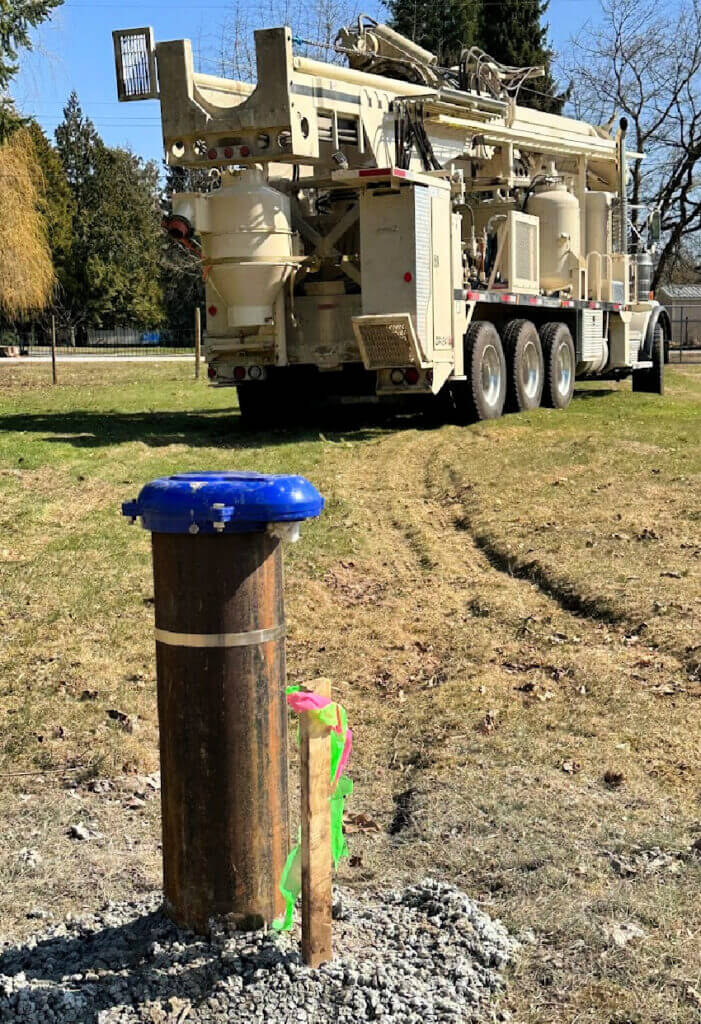
Abbotsford | Clearbrook | Chilliwack | Yarrow | Sardis | Ryder Lake | Harrison Lake | Hope | Ladner | Langley | Fort Langley | Aldergrove | Cloverdale | Maple Ridge | Albion | Whonnock | Ruskin | Pitt Meadows | Mission | Deroche | Dewdney | Surrey | Squamish | Whistler | Pemberton